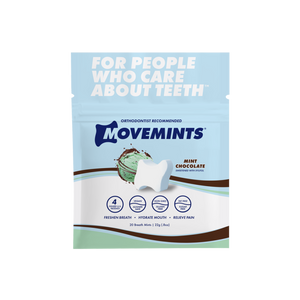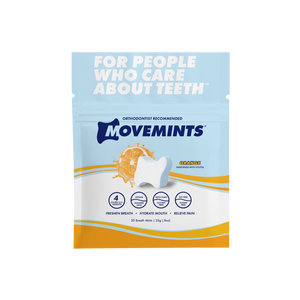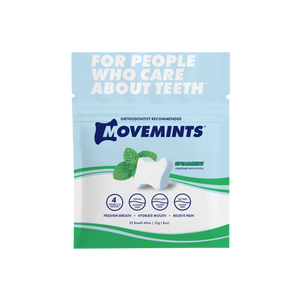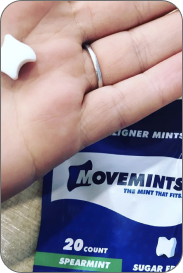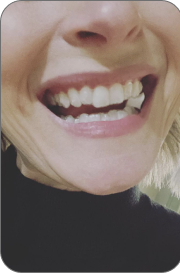Looking for invisalign pain relief at night? Keep reading to find out how you can curb discomfort before bed
 It’s common to experience Invisalign pain at the beginning of your treatment or after switching to a new tray. There are a lot of people on their Invisalign journey that experience discomfort not only during the day, but before they go to bed, which makes it difficult to get to sleep. If you’re stumped on how you can remedy aligner discomfort at night, keep reading to find out how you can find Invisalign pain relief using tips and tricks from Movemints! By using the right methods and Invisalign accessories you’ll be off to a sound and comfortable sleep before you know it.
It’s common to experience Invisalign pain at the beginning of your treatment or after switching to a new tray. There are a lot of people on their Invisalign journey that experience discomfort not only during the day, but before they go to bed, which makes it difficult to get to sleep. If you’re stumped on how you can remedy aligner discomfort at night, keep reading to find out how you can find Invisalign pain relief using tips and tricks from Movemints! By using the right methods and Invisalign accessories you’ll be off to a sound and comfortable sleep before you know it.
What is the Difference Between Daytime and Nighttime Invisalign Pain?
Nighttime Invisalign pain relief requires different remedies than daytime aligner pain
 Don’t lose sleep over your Invisalign! Symptoms should subside in a couple of days.
Don’t lose sleep over your Invisalign! Symptoms should subside in a couple of days.
Invisalign clear aligners straighten your teeth by applying constant pressure until your teeth are moved into their correct position. When your teeth begin to move, it often causes pain and discomfort that can last anywhere from a few hours to a few days.
The level of discomfort should be similar during the day and during the night. For most, the discomfort will be more noticeable as you are trying to fall asleep, which is definitely a source of frustration for Invisalign users. However, if your aligner pain is more acute during the night, then there may be an issue with teeth grinding or sleeping position that is causing soreness. That’s why we’re taking a look at some of the best strategies for Invisalign pain relief at nighttime. Let’s get started!
Invisalign Pain Relief Begins at the Source
Looking for Invisalign pain relief at night? Start by pinpointing where it hurts
 For some cases of Invisalign pain, all it takes is orthodontic wax to find relief.
For some cases of Invisalign pain, all it takes is orthodontic wax to find relief.
The first step toward Invisalign pain relief is locating the source of your pain. Is your pain in a specific area of your gums? Is it your whole mouth? Does the pain feel like a dull soreness or a sharp edge?
By asking yourself these questions, you can determine how to proceed with pain relief. For example, if you are having pain in one specific spot, it is probably due to Invisalign sharp edges rubbing against your gums or cheek. An easy fix for aligners poking or chafing into your gums or cheeks is wax for Invisalign. When applying dental wax, ensure your teeth and your aligners are clean and make sure the affected area is dry, otherwise the wax may not adhere properly.
Monitor Your Sleeping Position
Altering your sleeping position can help with Invisalign pain relief
 Laying on your back can help with overnight soreness.
Laying on your back can help with overnight soreness.
After starting Invisalign or just after switching trays many users have pain as their teeth adjust to their new position. While this is happening, your sleeping position can affect aligner related pain. If you are waking up in the middle of the night with greater pain than when you went to sleep, a different sleeping position might just be the solution to your problem.
For the best night’s sleep with Invisalign, try sleeping on your back with a pillow to keep your head elevated. Sometimes when you sleep on your front or on your side, you are putting extra pressure on your teeth and gums which exacerbates sensitivity. Just by switching up your sleeping position, you can find Invisalign pain relief.
Keep Wearing Your Invisalign Clear Aligners
Sometimes patience is the key to nighttime Invisalign pain relief
 Invisalign pain will subside eventually.
Invisalign pain will subside eventually.
Though Invisalign discomfort is annoying, it won’t last forever. Even if your Invisalign is causing you some pain, it is important to remember not to remove your aligners. By removing your aligners, you could be setting yourself back in your treatment. That means that you are only prolonging your treatment which will require more trays and more adjustment time.
There is, of course, a limit to the normal amount of pain that most Invisalign wearers experience. For most Invisalign wearers, pain will subside within 1-2 days. If you are experiencing night time pain for more than a week, you should talk to your orthodontist so they can identify why you are still experiencing pain.
Can’t Seem to Find Invisalign Pain Relief? Talk to Your Orthodontist
Your orthodontist can give you further tips for Invisalign pain relief based on their professional evaluation
 Can’t find a solution for Invisalign pain? It’s time to ask a professional.
Can’t find a solution for Invisalign pain? It’s time to ask a professional.
If you’ve tried your best with the daytime Invisalign remedies and the nighttime strategies we’ve listed and your Invisalign still hurts, then you should consult your orthodontist. Your orthodontist is the best source of information about your Invisalign journey. After they hear about your aligner related pain and where the pain is coming from, they will check your aligners, teeth, and gums to make sure there isn’t a more serious underlying issue. Ultimately, some Invisalign pain is normal, but excessive, prolonged discomfort should be examined by a professional.
If you have more questions about Invisalign pain relief or have more questions about general Invisalign care, check out our Movemints blog to answer every question you have about straightening your teeth with clear aligners! Your perfect smile could be just around the corner!






